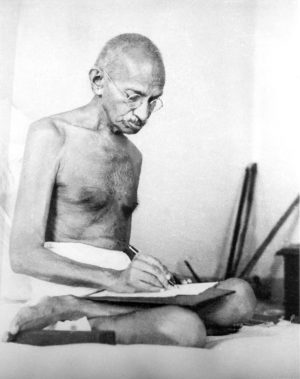Mahatma Gandhi wrote some books during his life, but many of these books were not published in book form. Most were collections of his papers about nonviolence and self-sufficiency and his speeches to students and women.
Scholars today agree that Gandhi was a writer who had a clear style. He was not known to write in an artificial voice, and he did not use complicated words to sound more intelligent than he was. Gandhi developed a powerful writing voice that reflected his faith, hopes, failures, and dreams. He wrote in a simple and clear voice and did not use much ornamentation in his language, in very much the same way that he did not use ornamentation in his life. Some English officials observed that Gandhi communicated his ideas in simple and straightforward English and that he understood the economy of words. One professor at Oxford University once helped Gandhi draft remarks he made at the Round Table Conference. He stated that Gandhi had a powerful command of prepositions in the English language. This clear and direct style that Gandhi developed most likely came as a result of his fondness for the Bible, which used plain language, and also for English writers. The simple prose style developed in him a keen sense of the value of words.
Gandhi finished his first written work when he was a teenager in the form of a booklet called London Guide, which he wrote for Indian students to find their way around London. This was followed by An Appeal to Every Briton, which discusses the situation of Natal Indians. After this, he wrote The Indian Franchise, which focused on the history of the Indian franchise in Natal. In 1896, Gandhi wrote The Green Pamphlet, in which he narrated the situation of Indian laborers who were bound by contract to work for food and housing. It was written in a matter-of-fact voice, and a month after it was published, a second edition came off the press. The condensed version of The Green Pamphlet enraged the Europeans, and as a result, when Gandhi next arrived in South Africa, he was mobbed. This is the moment that Gandhi realized that his written works were better off not condensed.
Apart from his ideas on peace and politics, Gandhi also wrote about health. He liked to experiment with different diets, and he recorded his observations in A Guide to Health. This written work of Gandhi was read by a huge number of people in India and was translated into English, other European languages, and Indian languages. Once Gandhi fancied an idea, his mind did not let go of it. His urge was to write it down, without any pretense or fear of being laughed at. Even while on a train or a ship, he would reach for a piece of paper and write down his thoughts, as he did with The Green Pamphlet, which he wrote while on a trip home in 1896. In 1909, during a voyage from England to South Africa, he wrote down Hind Swaraj or Indian home rule. It is said that when his right hand became exhausted with writing, he turned to his left hand. In 10 days, Gandhi finished the book. The Russian novelist Leo Tolstoy, who exchanged letters with Gandhi, appreciated Hind Swaraj and stated that passive resistance is a very important concept that the world should learn.
Another work that Gandhi finished while traveling by train was a booklet about nation-building entitled Constructive Program. In this work, Gandhi discusses the creation of a society that is founded on truth and nonviolence.
Gandhi had a talent for converting foreign ideas into another language. The English writer and philosopher John Ruskin wrote a book entitled “Unto This Last,” wherein he taught that helping the poor is the moral obligation of the educated. Ruskin’s sentiments reverberated with Gandhi’s beliefs; according to Gandhi, the book transformed him permanently. He adopted Ruskin’s ideas, translated them into Gujarati, and called it sarvodaya, meaning “the welfare of all.” Although Gandhi went on to learn many languages, Gujarati was his first language. It was the language that natives spoke in the Indian state of Gujarat.
Gandhi’s autobiography, The Story of My Experiments with Truth, was written in Gujarati. With his autobiography, Gandhi transformed his native language into a powerful language of clarity. His autobiography has been translated into the English language, and since then, it has been judged by scholars as great literature. It narrated events about his wife and friends and the most important events of his life in a very entertaining account. Gandhi’s autobiography has since been translated into Russian, Chinese, German, Japanese, French, and most Indian languages.
Gandhi’s written works all contain the love of truth and intense moral convictions and are not a smattering of stiff rules of behavior. He wrote a textbook for children entitled Balpothi, in which he taught that boys and girls should share in household chores like sweeping the floor, washing the clothes, and cooking. He advocated that gender should not matter when it comes to responsibilities around the house.
Gandhi was opposed to the concept of art for art’s sake. In his view, art should be based on truth and should point to higher truths. He was among those who believed that the function of literature was to uplift humanity’s condition. He was known to be very fond of the poet Raichandbhai and was once asked to write a biography of him. Gandhi replied that if he were to write about the life of the poet, he should first study the home he grew up in, where he played as a child, his schoolmates, and his friends. This remark only showed that Gandhi included nothing but the truth in his writings, and the truth was the main force that guided his writing voice throughout his essays and letters.
